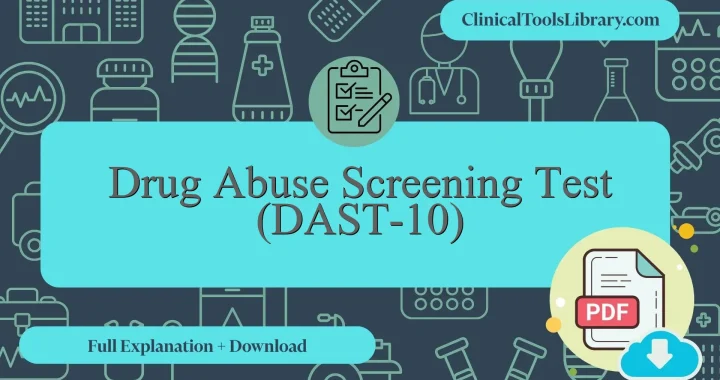In this article, we explain everything you need to know about the Drug Abuse Screening Test (DAST-10). We will cover the aspects it evaluates, the target population, a detailed step-by-step explanation, and how to interpret its results. Additionally, we will dive into the scientific evidence supporting this tool (diagnostic sensitivity and specificity) in clinical assessment. You will also find official and unofficial sources available for download in PDF format.
What does the Drug Abuse Screening Test (DAST-10) assess?
The Drug Abuse Screening Test (DAST-10) is a concise, standardized instrument designed to evaluate the extent of drug use-related problems excluding alcohol. Its primary purpose is to identify individuals who may be experiencing substance use disorders by assessing behaviors and consequences associated with drug consumption over the past year. The tool consists of ten items that quantify the severity and impact of illicit drug use, facilitating early detection and guiding clinical decision-making in various healthcare settings.
For which type of patients or populations is the Drug Abuse Screening Test (DAST-10) intended?
The Drug Abuse Screening Test (DAST-10) is indicated primarily for patients suspected of having substance use disorders and is widely used in both outpatient and inpatient settings to identify individuals at risk. This brief screening tool is particularly useful in populations such as adolescents, adults undergoing treatment for mental health conditions, and patients in primary care or emergency departments where rapid assessment is critical. The DAST-10 facilitates early detection of problematic drug use, enabling timely intervention and referral to specialized addiction services, thereby optimizing clinical outcomes in diverse healthcare environments.
Step-by-Step Explanation of the Drug Abuse Screening Test (DAST-10)
The Drug Abuse Screening Test (DAST-10) consists of 10 standardized items designed to evaluate the extent of individuals’ drug use and related problems, excluding alcohol. Each question addresses specific behaviors and consequences linked to drug consumption over the past 12 months. The response format is dichotomous, requiring patients to answer “yes” or “no”, facilitating straightforward scoring where each affirmative answer is assigned one point. Clinicians administer the DAST-10 by systematically presenting each item, ensuring clarity to promote accurate and honest responses. The cumulative score ranges from 0 to 10, with higher scores indicating a greater degree of drug abuse severity, which aids in determining the need for further evaluation or intervention.
Downloadable DAST-10 Drug Abuse Screening Test PDF Resources for Healthcare Professionals
Healthcare professionals will find downloadable resources available below, including both the original and English versions of the Drug Abuse Screening Test (DAST-10) in PDF format. These tools facilitate accurate assessment and early identification of substance use disorders, supporting effective intervention strategies within clinical settings.
How to interpret the results of the Drug Abuse Screening Test (DAST-10)?
The Drug Abuse Screening Test (DAST-10) results are interpreted by summing the number of affirmative responses, yielding a score from 0 to 10. Scores of 0 indicate no problems related to drug abuse, 1–2 suggest a low level of concern, 3–5 reflect a moderate level requiring further assessment, while scores of 6 or higher signify a substantial level of problems associated with substance misuse. For example, a score of 4 implies a moderate risk, warranting more comprehensive evaluation or intervention. Healthcare professionals utilize these stratified score ranges to identify the severity of drug-related issues, enabling informed decisions regarding referral to specialized treatment, monitoring, or behavioral counseling. The straightforward numerical interpretation facilitates timely and objective clinical judgment in managing patients with potential drug abuse disorders.
What scientific evidence supports the Drug Abuse Screening Test (DAST-10) ?
The Drug Abuse Screening Test (DAST-10), developed in 1982 by Skinner, has undergone extensive validation studies demonstrating robust psychometric properties. Historically derived from a longer 28-item version, the concise 10-item format retains high sensitivity and specificity for identifying substance use disorders other than alcohol. Validation across diverse populations, including clinical and community samples, confirms its reliability and construct validity. Studies utilizing both classical test theory and modern item response theory support the tool’s efficacy for screening drug-related problems, with strong internal consistency (Cronbach’s alpha typically exceeding 0.80) and predictive validity for detecting severity of drug abuse. Its widespread adoption in primary care and mental health settings underscores the scientific foundation underpinning its clinical utility.
Diagnostic Accuracy: Sensitivity and Specificity of the Drug Abuse Screening Test (DAST-10)
The Drug Abuse Screening Test (DAST-10) demonstrates a sensitivity ranging from 76% to 90%, indicating its effectiveness in correctly identifying individuals with substance use disorders. Its specificity varies between 61% and 90%, reflecting the test’s ability to accurately exclude non-users. These metrics can differ based on the population studied and the threshold scores applied. Overall, the DAST-10 is recognized as a reliable screening instrument for detecting drug abuse in clinical and research settings, balancing both sensitivity and specificity to optimize case identification while minimizing false positives.
Related Scales or Questionnaires
The Drug Abuse Screening Test (DAST-10) shares similarities with several other assessment tools, such as the Alcohol Use Disorders Identification Test (AUDIT), the Substance Abuse Subtle Screening Inventory (SASSI), and the CAGE questionnaire. Each of these scales, explained and available for download on ClinicalToolsLibrary.com, serves to identify substance use issues but differs in scope and specificity. For example, the AUDIT provides a broader evaluation of alcohol use patterns but may be less sensitive to drug abuse alone. The SASSI offers a more comprehensive psychological profile, yet its administration requires more time and training. The CAGE questionnaire is brief and easy to administer but may not detect early or less severe substance use disorders. While the DAST-10 emphasizes drug use consequences with moderate length and validated reliability, clinicians should select tools based on the target substance, patient population, and required assessment depth.




